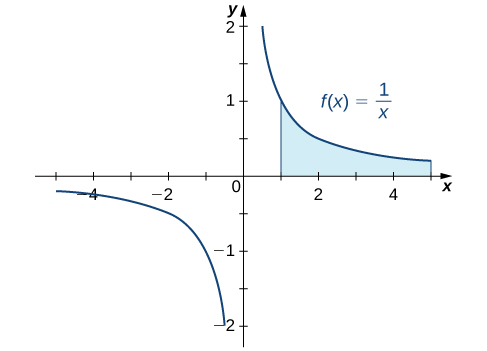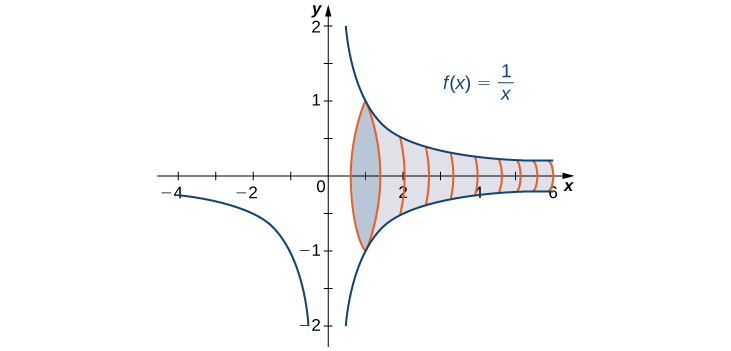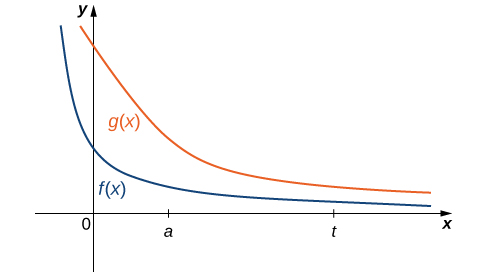3.7 Improper Integrals
Learning Objectives
- Evaluate an integral over an infinite interval.
- Evaluate an integral over a closed interval with an infinite discontinuity within the interval.
- Use the comparison theorem to determine whether a definite integral is convergent.
Is the area between the graph of ![]() and the x-axis over the interval
and the x-axis over the interval ![]() finite or infinite? If this same region is revolved about the x-axis, is the volume finite or infinite? Surprisingly, the area of the region described is infinite, but the volume of the solid obtained by revolving this region about the x-axis is finite.
finite or infinite? If this same region is revolved about the x-axis, is the volume finite or infinite? Surprisingly, the area of the region described is infinite, but the volume of the solid obtained by revolving this region about the x-axis is finite.
In this section, we define integrals over an infinite interval as well as integrals of functions containing a discontinuity on the interval. Integrals of these types are called improper integrals. We examine several techniques for evaluating improper integrals, all of which involve taking limits.
Integrating over an Infinite Interval
How should we go about defining an integral  We know how to evaluate
We know how to evaluate  for any value of
for any value of ![]() so it is reasonable to look at the behavior of this integral as we substitute larger values of
so it is reasonable to look at the behavior of this integral as we substitute larger values of ![]() In Figure 1 below
In Figure 1 below  is interpreted as area below the graph of
is interpreted as area below the graph of ![]() over an interval
over an interval ![]() for various values of
for various values of ![]() In other words, we may define an improper integral as a limit, taken as one of the limits of integration increases or decreases without bound.
In other words, we may define an improper integral as a limit, taken as one of the limits of integration increases or decreases without bound.

Definition
- Let
 be continuous over an interval
be continuous over an interval  Then
Then

provided this limit exists. - Let
 be continuous over an interval of the form
be continuous over an interval of the form ![Rendered by QuickLaTeX.com \ds \left( - \infty ,b\right].](https://pressbooks.openedmb.ca/app/uploads/quicklatex/quicklatex.com-b214e61c466104a003db23e6b84b4073_l3.png) Then
Then

provided this limit exists.In each case, if the limit exists, then the improper integral is said to converge. If the limit does not exist, then the improper integral is said to diverge.
- Let
 be continuous over
be continuous over  We define
We define  as
as

provided that both and
and  converge.
converge.
If either of these two integrals is divergent, then diverges. (It can be shown that, in fact,
diverges. (It can be shown that, in fact,  for any value of
for any value of  )
)
In our first example, we return to the question we posed at the start of this section: Is the area between the graph of ![]() and the
and the ![]() -axis over the interval
-axis over the interval ![]() finite or infinite?
finite or infinite?
Finding an Area
Determine whether the area between the graph of ![]() and the x-axis over the interval
and the x-axis over the interval ![]() is finite or infinite.
is finite or infinite.
Solution
We first do a quick sketch of the region in question, as shown in the following graph.

 and the x-axis on an infinite interval.
and the x-axis on an infinite interval.We can see that the area of this region is given by  Then we have
Then we have
![Rendered by QuickLaTeX.com \ds \begin{array}{ccccc}\hfill A&\ds =\int\limits_{1}^{\infty }\frac{1}{x}\,dx \hfill &\ds &\ds &\ds \\[5mm]\ds &\ds =\underset{t\to \infty }{\text{lim}}\int\limits_{1}^{t}\frac{1}{x}\,dx \hfill &\ds &\ds &\ds \text{Rewrite the improper integral as a limit.}\hfill \\[5mm]\ds &\ds =\underset{t\to \infty }{\text{lim}}\text{ln}|x|\Big|_1^t\hfill &\ds &\ds &\ds \text{Find the antiderivative.}\hfill \\[5mm]\ds &\ds =\underset{t\to \infty }{\text{lim}}\left(\text{ln}|t|-\text{ln}\phantom{\rule{0.1em}{0ex}}(1)\right)\hfill &\ds &\ds &\ds \text{Evaluate the antiderivative.}\hfill \\[5mm]\ds &\ds =\infty .\hfill &\ds &\ds &\ds \text{Evaluate the limit.}\hfill \end{array}](https://pressbooks.openedmb.ca/app/uploads/quicklatex/quicklatex.com-9e6cd31b6a795c0a3cfb8430de1cbdcc_l3.png)
Since the improper integral diverges to ![]() the area of the region is infinite.
the area of the region is infinite.
Finding a Volume
Find the volume of the solid obtained by revolving the region bounded by the graph of ![]() and the x-axis over the interval
and the x-axis over the interval ![]() about the
about the ![]() -axis.
-axis.
Solution
The solid is shown in Figure 3 below. Using the disk method, we see that the volume V is


Then we have
![Rendered by QuickLaTeX.com \ds \begin{array}{ccccc}\hfill V&\ds =\pi \int\limits_{1}^{\infty }\frac{1}{{x}^{2}}\,dx \hfill &\ds &\ds &\ds \\[5mm]\ds &\ds =\pi \underset{t\to \infty }{\text{lim}}\int\limits_{1}^{t}\frac{1}{{x}^{2}}\,dx \hfill &\ds &\ds &\ds \text{Rewrite as a limit.}\hfill \\[5mm]\ds &\ds =\pi \underset{t\to \infty }{\text{lim}}\left(-\frac{1}{x}\right)\Big|_1^t\hfill &\ds &\ds &\ds \text{Find the antiderivative.}\hfill \\[5mm]\ds &\ds =\pi \underset{t\to \infty }{\text{lim}}\left( - \phantom{\rule{0.2em}{0ex}}\frac{1}{t}+1\right)\hfill &\ds &\ds &\ds \text{Evaluate the antiderivative.}\hfill \\[5mm]\ds &\ds =\pi .\hfill &\ds &\ds &\ds \end{array}](https://pressbooks.openedmb.ca/app/uploads/quicklatex/quicklatex.com-4bf81cce4d57ec23c2796cc87267cd7b_l3.png)
The improper integral converges to ![]() Therefore, the volume of the solid of revolution is
Therefore, the volume of the solid of revolution is ![]()
In conclusion, although the area of the region between the x-axis and the graph of ![]() over the interval
over the interval ![]() is infinite, the volume of the solid generated by revolving this region about the x-axis is finite. The solid generated is known as Gabriel’s Horn.
is infinite, the volume of the solid generated by revolving this region about the x-axis is finite. The solid generated is known as Gabriel’s Horn.
You can read more about Gabriel’s Horn on Wikipedia.
Chapter Opener: Traffic Accidents in a City

In the chapter opener, we stated the following problem: Suppose that at a busy intersection, traffic accidents occur at an average rate of one every three months. After residents complained, changes were made to the traffic lights at the intersection. It has now been eight months since the changes were made and there have been no accidents. Were the changes effective or is the 8-month interval without an accident a result of chance?
Probability theory tells us that if the average time between events is ![]() the probability that
the probability that ![]() the time between events, is between
the time between events, is between ![]() and
and ![]() is given by
is given by
![Rendered by QuickLaTeX.com \ds P\left(a\le x\le b\right)=\int\limits_{a}^{b}f\left(x\right)\,dx \phantom{\rule{0.2em}{0ex}}\text{where}\phantom{\rule{0.2em}{0ex}}f\left(x\right)=\left\{\begin{array}{ll}0\phantom{\rule{0.2em}{0ex}}\ &\text{if}\ \phantom{\rule{0.1em}{0ex}}x<0\\[3mm]\ds k{e}^{ - kx}\ &\text{if}\ \phantom{\rule{0.1em}{0ex}}x\ge 0\end{array}.](https://pressbooks.openedmb.ca/app/uploads/quicklatex/quicklatex.com-ddf07c63d641bc47f537c32632c299ba_l3.png)
Thus, if accidents are occurring at a rate of one every 3 months, then the probability that ![]() the time between accidents, is between
the time between accidents, is between ![]() and
and ![]() is given by
is given by
![Rendered by QuickLaTeX.com \ds P\left(a\le x\le b\right)=\int\limits_{a}^{b}f\left(x\right)\,dx \phantom{\rule{0.2em}{0ex}}\text{where}\phantom{\rule{0.2em}{0ex}}f\left(x\right)=\left\{\begin{array}{ll}0\ \phantom{\rule{0.2em}{0ex}}&\text{if}\ \phantom{\rule{0.1em}{0ex}}x<0\\[3mm]\ds 3{e}^{-3x}\ &\text{if}\ \phantom{\rule{0.1em}{0ex}}x\ge 0\end{array}.](https://pressbooks.openedmb.ca/app/uploads/quicklatex/quicklatex.com-5a2509075080b601c2bea589de4cb804_l3.png)
To answer the question, we must compute  and decide whether it is likely that 8 months could have passed without an accident if there had been no improvement in the traffic situation.
and decide whether it is likely that 8 months could have passed without an accident if there had been no improvement in the traffic situation.
Solution
We need to calculate the probability as an improper integral:
![Rendered by QuickLaTeX.com \ds \begin{array}{cc}\ds \hfill P\left(X\ge 8\right)&\ds =\int\limits_{8}^{\infty }3{e}^{-3x}\,dx \hfill \\[5mm]\ds &\ds =\underset{t\to \infty }{\text{lim}}\int\limits_{8}^{t}3{e}^{-3x}\,dx \hfill \\[5mm]\ds &\ds =\underset{t\to \infty }{\text{lim}}{ - {e}^{-3x}}\Big|_{8}^{t}\hfill \\[5mm]\ds &\ds =\underset{t\to \infty }{\text{lim}}\left( - {e}^{-3t}+{e}^{-24}\right)\hfill \\[5mm]\ds &\ds =e^{-24}\approx 3.8\phantom{\rule{0.2em}{0ex}}\cdot\phantom{\rule{0.2em}{0ex}}{10}^{-11}.\hfill \end{array}](https://pressbooks.openedmb.ca/app/uploads/quicklatex/quicklatex.com-8cb309e7f067127c99265e9d405f9758_l3.png)
The value ![]() represents the probability of no accidents in 8 months under the initial conditions. Since this value is very, very small, it is reasonable to conclude that the changes were effective.
represents the probability of no accidents in 8 months under the initial conditions. Since this value is very, very small, it is reasonable to conclude that the changes were effective.
Evaluating an Improper Integral over an Infinite Interval
Evaluate  State whether the improper integral converges or diverges.
State whether the improper integral converges or diverges.
Solution
Begin by rewriting  as a limit using the definition. We have:
as a limit using the definition. We have:
![Rendered by QuickLaTeX.com \ds \begin{array}{ccccc}\hfill \ds\int\limits_{ - \infty }^{0}\frac{1}{{x}^{2}+4}\,dx &\ds =\underset{t\to - \infty }{\text{lim}}\int\limits_{t}^{0}\frac{1}{{x}^{2}+4}\,dx \hfill &\ds &\ds &\ds \text{Rewrite as a limit.}\hfill \\[5mm]\ds &\ds =\underset{t\to - \infty }{\text{lim}}\frac{1}{2}{\text{tan}}^{-1}\left(\frac{x}{2}\right)\Big|_t^0\hfill &\ds &\ds &\ds \text{Find the antiderivative.}\hfill \\[5mm]\ds &\ds =\frac{1}{2}\underset{t\to - \infty }{\text{lim}}\left({\text{tan}}^{-1}(0)-{\text{tan}}^{-1}\left(\frac{t}{2}\right)\right)\hfill &\ds &\ds &\ds \text{Evaluate the antiderivative.}\hfill \\[5mm]\ds &\ds =\frac{\pi }{4}.\hfill &\ds &\ds &\ds \text{Evaluate the limit and simplify.}\hfill \end{array}](https://pressbooks.openedmb.ca/app/uploads/quicklatex/quicklatex.com-cd80191ea8018af39891505cae259cce_l3.png)
The improper integral converges to ![]()
Evaluating an Improper Integral over 
Evaluate  State whether the improper integral is convergent or divergent.
State whether the improper integral is convergent or divergent.
Solution
Start by splitting up the integral:

If either  or
or  diverges, then
diverges, then  diverges. Compute each integral separately. For the first integral,
diverges. Compute each integral separately. For the first integral,
![Rendered by QuickLaTeX.com \ds \begin{array}{ccccc}\hfill \ds\int\limits_{ - \infty }^{0}x{e}^{x}\,dx &\ds =\underset{t\to - \infty }{\text{lim}}\int\limits_{t}^{0}x{e}^{x}\,dx \hfill &\ds &\ds &\ds \text{Rewrite as a limit.}\hfill \\[5mm]\ds &\ds =\underset{t\to - \infty }{\text{lim}}\left(x{e}^{x}-{e}^{x}\right)\Big|_t^0\hfill &\ds &\ds &\ds \begin{array}{l}\text{Use integration by parts to find the}\hfill \\[5mm]\ds \text{antiderivative. (Here}\phantom{\rule{0.2em}{0ex}}u=x\phantom{\rule{0.2em}{0ex}}\text{and}\phantom{\rule{0.2em}{0ex}}dv={e}^{x}.)\hfill \end{array}\hfill \\[10mm]\ds &\ds =\underset{t\to - \infty }{\text{lim}}\left(-1-t{e}^{t}+{e}^{t}\right)\hfill &\ds &\ds &\ds \text{Evaluate the antiderivative.}\hfill \\[5mm]\ds &\ds =-1.\hfill &\ds &\ds &\ds \begin{array}{c}\text{Evaluate the limit.}\phantom{\rule{0.2em}{0ex}}\mathit{\text{Note:}}\phantom{\rule{0.2em}{0ex}}\underset{t\to - \infty }{\text{lim}}t{e}^{t}\phantom{\rule{0.2em}{0ex}}\text{is}\hfill \\[5mm]\ds \text{is of indeterminate form}\phantom{\rule{0.2em}{0ex}}0\cdot \infty .\phantom{\rule{0.2em}{0ex}}\text{Thus,}\hfill \\[5mm]\ds \underset{t\to - \infty }{\text{lim}}t{e}^{t}=\underset{t\to - \infty }{\text{lim}}\frac{t}{{e}^{ - t}}=\underset{t\to - \infty }{\text{lim}}\ \frac{1}{-{e}^{ - t}}\hfill \\[5mm]=\underset{t\to - \infty }{\text{lim}}-{e}^{t}=0\phantom{\rule{0.2em}{0ex}}\ds \text{by the L'Hôpital's Rule.}\hfill \end{array}\hfill \end{array}](https://pressbooks.openedmb.ca/app/uploads/quicklatex/quicklatex.com-48317d53efc9ae0064eb3c865c69e0c7_l3.png)
The first improper integral converges. For the second integral,
![Rendered by QuickLaTeX.com \ds \begin{array}{ccccc}\hfill \ds\int\limits_{0}^{\infty }x{e}^{x}\,dx &\ds =\underset{t\to \infty }{\text{lim}}\int\limits_{0}^{t}x{e}^{x}\,dx \hfill &\ds &\ds &\ds \text{Rewrite as a limit.}\hfill \\[5mm]\ds &\ds =\underset{t\to \infty }{\text{lim}}\left(x{e}^{x}-{e}^{x}\right)\Big|_0^t\hfill &\ds &\ds &\ds \text{Find the antiderivative.}\hfill \\[5mm]\ds &\ds =\underset{t\to \infty }{\text{lim}}\left(t{e}^{t}-{e}^{t}+1\right)\hfill &\ds &\ds &\ds \text{Evaluate the antiderivative.}\hfill \\[5mm]\ds &\ds =\underset{t\to \infty }{\text{lim}}\left(\left(t-1\right){e}^{t}+1\right)\hfill &\ds &\ds &\ds \text{Rewrite.}\phantom{\rule{0.2em}{0ex}}\left(t{e}^{t}-{e}^{t}\phantom{\rule{0.2em}{0ex}}\text{is indeterminate.)}\hfill \\[5mm]\ds &\ds =\infty .\hfill &\ds &\ds &\ds \text{Evaluate the limit.}\hfill \end{array}](https://pressbooks.openedmb.ca/app/uploads/quicklatex/quicklatex.com-7491b795b5602a219057bc2649ba9484_l3.png)
Thus,  diverges. Since this integral diverges,
diverges. Since this integral diverges,  diverges as well.
diverges as well.
Evaluate  State whether the improper integral converges or diverges.
State whether the improper integral converges or diverges.
Answer
![]() converges
converges
Hint

Integrating a Discontinuous Function
We now examine integrals of functions containing an infinite discontinuity in the interval over which the integration occurs. Consider an integral of the form  where
where ![]() is continuous over
is continuous over ![]() and discontinuous at
and discontinuous at ![]() Since the function
Since the function ![]() is continuous over
is continuous over ![]() for all
for all ![]() satisfying
satisfying ![]() the integral
the integral  is defined for all such values of
is defined for all such values of ![]() Hence, it makes sense to consider the values of
Hence, it makes sense to consider the values of  as
as ![]() approaches
approaches ![]() for
for ![]() That is, we define
That is, we define  provided this limit exists. The figure below illustrates
provided this limit exists. The figure below illustrates  as areas of regions for values of
as areas of regions for values of ![]() approaching
approaching ![]()

We use a similar approach to define  where
where ![]() is continuous over
is continuous over ![]() and discontinuous at
and discontinuous at ![]() We now proceed with a formal definition.
We now proceed with a formal definition.
Definition
- Let
 be continuous over
be continuous over  Then,
Then,

- Let
 be continuous over
be continuous over ![Rendered by QuickLaTeX.com \ds \left(a,b\right].](https://pressbooks.openedmb.ca/app/uploads/quicklatex/quicklatex.com-86dfb5b6323cd01c21047f95412a55fa_l3.png) Then,
Then,

In each case, if the limit exists, then the improper integral is said to converge. If the limit does not exist, then the improper integral is said to diverge. - If
 is continuous over
is continuous over ![Rendered by QuickLaTeX.com \ds \left[a,b\right]](https://pressbooks.openedmb.ca/app/uploads/quicklatex/quicklatex.com-c3ac37860878a36cf1c719379b6192f8_l3.png) except at a point
except at a point  in
in  then we define
then we define  as
as

provided both and
and  converge. If either of these two integrals diverges, then
converge. If either of these two integrals diverges, then  diverges.
diverges.
The following examples demonstrate the application of this definition.
Integrating a Discontinuous Integrand
Evaluate  if possible. State whether the integral converges or diverges.
if possible. State whether the integral converges or diverges.
Solution
The function ![]() is continuous over
is continuous over ![]() and discontinuous at 4. Using the above definition, we rewrite
and discontinuous at 4. Using the above definition, we rewrite  as a limit:
as a limit:
![Rendered by QuickLaTeX.com \ds \begin{array}{ccccc}\hfill \ds\int\limits_{0}^{4}\frac{1}{\sqrt{4-x}}\,dx &\ds =\underset{t\to {4}^{-}}{\text{lim}}\int\limits_{0}^{t}\frac{1}{\sqrt{4-x}}\,dx \hfill &\ds &\ds &\ds \text{Rewrite as a limit.}\hfill \\[5mm]\ds &\ds =\underset{t\to {4}^{-}}{\text{lim}}\big(-2\sqrt{4-x}\big)\Big|_0^t\hfill &\ds &\ds &\ds \text{Find the antiderivative.}\hfill \\[5mm]\ds &\ds =\underset{t\to {4}^{-}}{\text{lim}}\big(-2\sqrt{4-t}+4\big)\hfill &\ds &\ds &\ds \text{Evaluate the antiderivative.}\hfill \\[5mm]\ds &\ds =4.\hfill &\ds &\ds &\ds \text{Evaluate the limit.}\hfill \end{array}](https://pressbooks.openedmb.ca/app/uploads/quicklatex/quicklatex.com-4fa5a863c072b86b47b3418d4c027e0c_l3.png)
Because the limit exists, the improper integral converges.
Integrating a Discontinuous Integrand
Evaluate  State whether the integral converges or diverges.
State whether the integral converges or diverges.
Solution
Since ![]() is continuous over
is continuous over ![]() and is discontinuous at zero, we can rewrite the integral as a limit using the definition of improper integral of the corresponding type:
and is discontinuous at zero, we can rewrite the integral as a limit using the definition of improper integral of the corresponding type:
![Rendered by QuickLaTeX.com \ds \begin{array}{ccccc}\hfill \ds\int\limits_{0}^{2}x\phantom{\rule{0.1em}{0ex}}\text{ln}\phantom{\rule{0.1em}{0ex}}(x)\phantom{\rule{0.1em}{0ex}}\,dx &\ds =\underset{t\to {0}^{+}}{\text{lim}}\int\limits_{t}^{2}x\phantom{\rule{0.1em}{0ex}}\text{ln}\phantom{\rule{0.1em}{0ex}}(x)\phantom{\rule{0.1em}{0ex}}\,dx \hfill &\ds &\ds &\ds \text{Rewrite as a limit.}\hfill \\[5mm]\ds &\ds =\underset{t\to {0}^{+}}{\text{lim}}\left(\frac{1}{2}{x}^{2}\text{ln}\phantom{\rule{0.1em}{0ex}}(x)-\frac{1}{4}{x}^{2}\right)\Big|_t^2\hfill &\ds &\ds &\ds \begin{array}{c}\text{Evaluate}\phantom{\rule{0.2em}{0ex}}{\int }^{\text{}}x\phantom{\rule{0.1em}{0ex}}\text{ln}\phantom{\rule{0.1em}{0ex}}(x)\phantom{\rule{0.1em}{0ex}}\,dx \phantom{\rule{0.2em}{0ex}}\text{using integration by parts}\hfill \\[5mm]\ds \text{with}\phantom{\rule{0.2em}{0ex}}u=\text{ln}\phantom{\rule{0.1em}{0ex}}(x)\phantom{\rule{0.2em}{0ex}}\text{and}\phantom{\rule{0.2em}{0ex}}dv=x.\hfill \end{array}\hfill \\[5mm]\ds &\ds =\underset{t\to {0}^{+}}{\text{lim}}\left(2\phantom{\rule{0.1em}{0ex}}\text{ln}\phantom{\rule{0.1em}{0ex}}2-1-\frac{1}{2}{t}^{2}\text{ln}\phantom{\rule{0.1em}{0ex}}(t)+\frac{1}{4}{t}^{2}\right).\hfill &\ds &\ds &\ds \text{Evaluate the antiderivative.}\hfill \\[5mm]\ds &\ds =2\phantom{\rule{0.1em}{0ex}}\text{ln}\phantom{\rule{0.1em}{0ex}}2-1.\hfill &\ds &\ds &\ds \begin{array}{c}\text{Evaluate the limit.}\phantom{\rule{0.2em}{0ex}}\underset{t\to {0}^{+}}{\text{lim}}{t}^{2}\text{ln}\phantom{\rule{0.1em}{0ex}}(t)\phantom{\rule{0.2em}{0ex}}\text{is indeterminate.}\hfill \\[5mm]\ds \text{To evaluate it, rewrite as a quotient and apply}\hfill \\[5mm]\ds \text{L'Hôpital's rule.}\hfill \end{array}\hfill \end{array}](https://pressbooks.openedmb.ca/app/uploads/quicklatex/quicklatex.com-8d0de107c6f6198b016bdb3bb1d13802_l3.png)
The improper integral converges.
Integrating a Discontinuous Integrand
Evaluate  State whether the improper integral converges or diverges.
State whether the improper integral converges or diverges.
Solution
Since ![]() is continuous at every point of
is continuous at every point of ![]() except zero, we use the corresponding definition to write
except zero, we use the corresponding definition to write

Our integral converges if both integrals on the right converge. If either of the two integrals on the right diverges, then the original integral diverges as well. Begin with 
![Rendered by QuickLaTeX.com \ds \begin{array}{ccccc}\hfill \ds\int\limits_{-1}^{0}\frac{1}{{x}^{3}}\,dx &\ds =\underset{t\to {0}^{-}}{\text{lim}}\int\limits_{-1}^{t}\frac{1}{{x}^{3}}\,dx \hfill &\ds &\ds &\ds \text{Rewrite as a limit.}\hfill \\[5mm]\ds &\ds =\underset{t\to {0}^{-}}{\text{lim}}\left(-\frac{1}{2{x}^{2}}\right)\Big|_{-1}^t\hfill &\ds &\ds &\ds \text{Find the antiderivative.}\hfill \\[5mm]\ds &\ds =\underset{t\to {0}^{-}}{\text{lim}}\left(-\frac{1}{2{t}^{2}}+\frac{1}{2}\right)\hfill &\ds &\ds &\ds \text{Evaluate the antiderivative.}\hfill \\[5mm]\ds &\ds =-\infty .\hfill &\ds &\ds &\ds \text{Evaluate the limit.}\hfill \end{array}](https://pressbooks.openedmb.ca/app/uploads/quicklatex/quicklatex.com-1401212fc46092d3249281266696e264_l3.png)
Therefore,  diverges, and hence
diverges, and hence  diverges regardless of the behavior of
diverges regardless of the behavior of  .
.
Evaluate  State whether the integral converges or diverges.
State whether the integral converges or diverges.
Answer
![]() diverges
diverges
Comparison Theorem
It is not always easy or even possible to evaluate an improper integral directly; however, by comparing it with another carefully chosen integral, it may be possible to determine its convergence or divergence. To see this, consider two continuous functions ![]() and
and ![]() satisfying
satisfying ![]() for
for ![]() . In this case, we may view integrals of these functions over intervals of the form
. In this case, we may view integrals of these functions over intervals of the form ![]() as areas, so by the comparison property for definite integrals, we have the relationship
as areas, so by the comparison property for definite integrals, we have the relationship


 for
for  then for
then for 

Thus, if then
then
 as well.
as well.
That is, if the area of the region between the graph of ![]() and the x-axis over
and the x-axis over ![]() is infinite, then the area of the region between the graph of
is infinite, then the area of the region between the graph of ![]() and the x-axis over
and the x-axis over ![]() is infinite too.
is infinite too.
On the other hand, if
 for some real number
for some real number ![]() then
then
 must converge to some value less than or equal to
must converge to some value less than or equal to ![]() since
since  increases as
increases as ![]() increases and
increases and  for all
for all ![]()
That is, if the area of the region between the graph of ![]() and the x-axis over
and the x-axis over ![]() is finite, then the area of the region between the graph of
is finite, then the area of the region between the graph of ![]() and the x-axis over
and the x-axis over ![]() is also finite.
is also finite.
These conclusions are summarized in the following theorem.
Comparison Theorem
Let ![]() and
and ![]() be continuous over
be continuous over ![]() Assume that
Assume that ![]() for
for ![]()
- If
 then
then 
- If
 where
where  is a real number, then
is a real number, then  for some real number
for some real number 
Applying the Comparison Theorem
Use the comparison theorem to show that  converges.
converges.
Solution
The integrand is continuous over ![]() and we can also see that for
and we can also see that for ![]() ,
, ![]()
so if  converges, then so does
converges, then so does  To evaluate
To evaluate  first rewrite it as a limit:
first rewrite it as a limit:
![Rendered by QuickLaTeX.com \ds \begin{array}{cc}\ds \hfill \int\limits_{1}^{\infty }{e}^{ - x}\,dx &\ds =\underset{t\to \infty }{\text{lim}}\int\limits_{1}^{t}{e}^{ - x}\,dx \hfill \\[5mm]\ds &\ds =\underset{t\to \infty }{\text{lim}}\left( - {e}^{ - x}\right)\Big|_1^t\hfill \\[5mm]\ds &\ds =\underset{t\to \infty }{\text{lim}}\left( - {e}^{ - t}+{e}^{1}\right)\hfill \\[5mm]\ds &\ds ={e}.\hfill \end{array}](https://pressbooks.openedmb.ca/app/uploads/quicklatex/quicklatex.com-3dfda9cd68fde1855a94e44e0356e6ec_l3.png)
Since the limit is finite,  converges, and hence, by the comparison theorem, so does
converges, and hence, by the comparison theorem, so does 
Applying the Comparison Theorem
Use the comparison theorem to show that  diverges for all
diverges for all ![]()
Solution
First we note that ![]() is continuous over
is continuous over ![]() . If
. If ![]() then
then ![]() for all
for all ![]() We already showed that
We already showed that  Therefore, by the comparison theorem,
Therefore, by the comparison theorem, diverges for all
diverges for all ![]()
Use the comparison theorem to show that  diverges.
diverges.
Hint
![]() on
on ![]()
Student Project: Laplace Transforms
In the last few chapters, we have looked at several ways to use integration for solving real-world problems. For this next project, we are going to explore a more advanced application of integration: integral transforms. Specifically, we describe the Laplace transform and some of its properties. The Laplace transform is used in engineering and physics to simplify the computations needed to solve some problems. It takes functions expressed in terms of time and transforms them to functions expressed in terms of frequency. It turns out that, in many cases, the computations needed to solve problems in the frequency domain are much simpler than those required in the time domain.
The Laplace transform is defined in terms of an integral as

Note that the input to a Laplace transform is a function of time, ![]() and the output is a function of frequency,
and the output is a function of frequency, ![]() Although many real-world examples require the use of complex numbers (involving the imaginary number
Although many real-world examples require the use of complex numbers (involving the imaginary number ![]() in this project we limit ourselves to functions of real numbers.
in this project we limit ourselves to functions of real numbers.
Let’s start with a simple example. Here we calculate the Laplace transform of ![]() . We have
. We have

This is an improper integral, so we express it in terms of a limit, which gives

Now we use integration by parts to evaluate the integral. Note that we are integrating with respect to t, so we treat the variable s as a constant. We have
![Rendered by QuickLaTeX.com \ds \begin{array}{cccccccc}\hfill u&\ds =\hfill &\ds t\hfill &\ds &\ds &\ds \hfill dv&\ds =\hfill &\ds {e}^{ - st}dt\hfill \\[2mm]\ds \hfill du&\ds =\hfill &\ds dt\hfill &\ds &\ds &\ds \hfill v&\ds =\hfill &\ds -\frac{1}{s}{e}^{ - st}.\hfill \end{array}](https://pressbooks.openedmb.ca/app/uploads/quicklatex/quicklatex.com-1dcd3f6551a8d7fa13a3cbc643312554_l3.png)
Then we obtain
![Rendered by QuickLaTeX.com \ds \begin{array}{cc}\ds \hfill \underset{z\to \infty }{\text{lim}}\int\limits_{0}^{z}t{e}^{ - st}dt&\ds =\underset{z\to \infty }{\text{lim}}\left[{\left[-\frac{t}{s}{e}^{ - st}\right]}\Big|_{0}^{z}+\frac{1}{s}\int\limits_{0}^{z}{e}^{ - st}dt\right]\hfill \\[5mm]\ds &\ds =\underset{z\to \infty }{\text{lim}}\left[\left[-\frac{z}{s}{e}^{ - sz}+\frac{0}{s}{e}^{-0s}\right]+\frac{1}{s}\int\limits_{0}^{z}{e}^{ - st}dt\right]\hfill \\[5mm]\ds &\ds =\underset{z\to \infty }{\text{lim}}\left[\left[-\frac{z}{s}{e}^{ - sz}+0\right]-\frac{1}{s}{\left[\frac{{e}^{ - st}}{s}\right]}\Big|_{0}^{z}\right]\hfill \\[5mm]\ds &\ds =\underset{z\to \infty }{\text{lim}}\left[\left[-\frac{z}{s}{e}^{ - sz}\right]-\frac{1}{{s}^{2}}\left[{e}^{ - sz}-1\right]\right]\hfill \\[5mm]\ds &\ds =\underset{z\to \infty }{\text{lim}}\left[-\frac{z}{s{e}^{sz}}\right]-\underset{z\to \infty }{\text{lim}}\left[\frac{1}{{s}^{2}{e}^{sz}}\right]+\underset{z\to \infty }{\text{lim}}\frac{1}{{s}^{2}}\hfill \\[5mm]\ds &\ds =0-0+\frac{1}{{s}^{2}}\hfill \\[5mm]\ds &\ds =\frac{1}{{s}^{2}}.\hfill \end{array}](https://pressbooks.openedmb.ca/app/uploads/quicklatex/quicklatex.com-99c13e39b5f0c89867aa14ba4ef440f5_l3.png)
- Calculate the Laplace transform of

- Calculate the Laplace transform of

- Calculate the Laplace transform of
 (Note, you will have to integrate by parts twice.)
(Note, you will have to integrate by parts twice.)
Laplace transforms are often used to solve differential equations. Differential equations are not covered in detail until later in this book; but, for now, let’s look at the relationship between the Laplace transform of a function and the Laplace transform of its derivative.
Let’s start with the definition of the Laplace transform. We have

- Use integration by parts to evaluate
 (Let
(Let  and
and 
After integrating by parts and evaluating the limit, you should see that
![Rendered by QuickLaTeX.com \ds L\left\{f\left(t\right)\right\}=\frac{f\left(0\right)}{s}+\frac{1}{s}\left[L\left\{{f}^{\prime }\left(t\right)\right\}\right].](https://pressbooks.openedmb.ca/app/uploads/quicklatex/quicklatex.com-b2a126f3f406f99394970c05356e6ab2_l3.png)
Then,

It follows that differentiation in the time domain simplifies to multiplication by s in the frequency domain.
The final thing we look at in this project is how the Laplace transforms of and its antiderivative are related. Let
and its antiderivative are related. Let  Then,
Then,

- Use integration by parts to evaluate
 (Let
(Let  and
and  Note that from the way we have defined
Note that from the way we have defined 
 )
)
As you might expect, you should see that

That is, integration in the time domain simplifies to division by s in the frequency domain.
Key Concepts
- Integrals of functions over infinite intervals are defined in terms of limits.
- Integrals of functions over an interval for which the function has a discontinuity at an endpoint may be defined in terms of limits.
- The convergence or divergence of an improper integral may be determined by comparing it with the value of an improper integral for which the convergence or divergence is known.
Key Equations
- Improper integrals
![Rendered by QuickLaTeX.com \ds \begin{array}{c}\ds\int\limits_{a}^{\infty }f\left(x\right)\,dx =\underset{t\to \infty }{\text{lim}}\int\limits_{a}^{t}f\left(x\right)\,dx \hfill \\[5mm]\ds \int\limits_{ - \infty }^{b}f\left(x\right)\,dx =\underset{t\to - \infty }{\text{lim}}\int\limits_{t}^{b}f\left(x\right)\,dx \hfill \\[5mm]\ds \int\limits_{ - \infty }^{\infty }f\left(x\right)\,dx =\int\limits_{ - \infty }^{0}f\left(x\right)\,dx +\int\limits_{0}^{\infty }f\left(x\right)\,dx \hfill \end{array}](https://pressbooks.openedmb.ca/app/uploads/quicklatex/quicklatex.com-50978710f767e9fb6cb2f4197cb3fd97_l3.png)
Exercises
Evaluate the following integrals, if possible. If the integral diverges, answer “divergent.”
1. 
Answer
divergent
2. 
3. 
Answer
![]()
4. 
5. 
Answer
![]()
6. 
7. Without integrating, determine whether the integral  converges or diverges by comparing the integrand with
converges or diverges by comparing the integrand with ![]()
Answer
converges
8. Without integrating, determine whether the integral  converges or diverges.
converges or diverges.
Determine whether the improper integrals converge or diverge. If possible, determine the value of the integrals that converge.
9. 
Answer
Converges to 1/2.
10. 
11. 
Answer
−4
12. 
13. 
Answer
![]()
14. 
15. 
Answer
diverges
16. 
17. 
Answer
diverges
18. 
19. ![]()
Answer
![]()
20. 
21. ![]()
Answer
diverges
22. 
23. 
Answer
diverges
24. 
25. 
Answer
diverges
Determine the convergence of each of the following integrals by comparison with the given integral. If the integral converges, find the number to which it converges.
26.  compare with
compare with 
27.  compare with
compare with 
Answer
Both integrals diverge.
Use the comparison theorem to determine whether the given improper integral converges or diverges.
28. 
29. 
Answer
diverges
30. 
31. 
(Hint: compare ![]() to
to ![]() .)
.)
Answer
converges
32. ![Rendered by QuickLaTeX.com \ds \int\limits_{2}^{\infty}\frac{x^5+\cot^{-1}(x)}{(\sqrt[3] x-1)^{17}}\,dx](https://pressbooks.openedmb.ca/app/uploads/quicklatex/quicklatex.com-dbd68bd3068a3195afa050fac8c30cc0_l3.png)
33. 
Answer
converges
Evaluate the integrals. If the integral is divergent, answer “diverges.”
34. ![]()
35. ![]()
Answer
diverges
36. ![Rendered by QuickLaTeX.com \ds \int\limits_{0}^{1}\frac{\,dx }{\sqrt[5]{1-x}}](https://pressbooks.openedmb.ca/app/uploads/quicklatex/quicklatex.com-a30ac24f433ebbf4c5d157886edb032c_l3.png)
37. 
Answer
diverges
38. 
39. 
Answer
![]()
40. 
41. 
Answer
diverges
42. 
43. 
Answer
![]()
44. 
45. 
Answer
6
46. ![Rendered by QuickLaTeX.com \ds \int\limits_{-27}^{1}\frac{\,dx }{\sqrt[3]{{x}^{2}}}](https://pressbooks.openedmb.ca/app/uploads/quicklatex/quicklatex.com-4ad3ee8e97b02ff85eb7f6c5f50b3da8_l3.png)
47. 
Answer
![]()
48. 
49. 
Answer
![]()
50. 
51. Evaluate 
Answer
![]()
52. Find the area of the region in the first quadrant between the curve ![]() and the x-axis.
and the x-axis.
53. Find the area of the region bounded by the curve ![]() the x-axis, and on the left by
the x-axis, and on the left by ![]()
Answer
7
54. Find the area under the curve ![]() bounded on the left by
bounded on the left by ![]()
55. Find the area under ![]() in the first quadrant.
in the first quadrant.
Answer
![]()
56. Find the volume of the solid generated by revolving the region under the curve ![]() from
from ![]() to
to ![]() about the x-axis.
about the x-axis.
57. Find the volume of the solid generated by revolving the region under the curve ![]() in the first quadrant about the y-axis.
in the first quadrant about the y-axis.
Answer
![]()
58. Find the volume of the solid generated by revolving the region under the curve ![]() in the first quadrant about the x-axis.
in the first quadrant about the x-axis.
The Laplace transform of a continuous function over the interval ![]() is defined by
is defined by  (see the Student Project). The domain of F is the set of all real numbers s such that the improper integral converges. Find the Laplace transform F of each of the following functions and give the domain of F.
(see the Student Project). The domain of F is the set of all real numbers s such that the improper integral converges. Find the Laplace transform F of each of the following functions and give the domain of F.
59. ![]()
Answer
![]()
60. ![]()
61. ![]()
Answer
![]()
62. ![]()
A function is a probability density function if it satisfies the following definition:  The probability that a random variable x lies between a and b is given by
The probability that a random variable x lies between a and b is given by 
63. Show that
![Rendered by QuickLaTeX.com \ds f\left(x\right)=\left\{\begin{array}{ll}0\phantom{\rule{0.1em}{0ex}}\ &\text{if}\ \phantom{\rule{0.1em}{0ex}}(x)<0\\[2mm]\ds 7{e}^{-7x}\ &\text{if}\ \phantom{\rule{0.1em}{0ex}}(x)\ge 0\end{array}](https://pressbooks.openedmb.ca/app/uploads/quicklatex/quicklatex.com-4ebd7d482de3e4b4e1e0d061869c3883_l3.png)
is a probability density function.
Answer

64. Using the function defined in the preceding problem, find the probability that x is between 0 and 1.
Glossary
- improper integral
- an integral over an infinite interval or an integral of a function containing an infinite discontinuity on the interval; an improper integral is defined in terms of a limit. The improper integral converges if this limit is a finite real number; otherwise, the improper integral diverges

